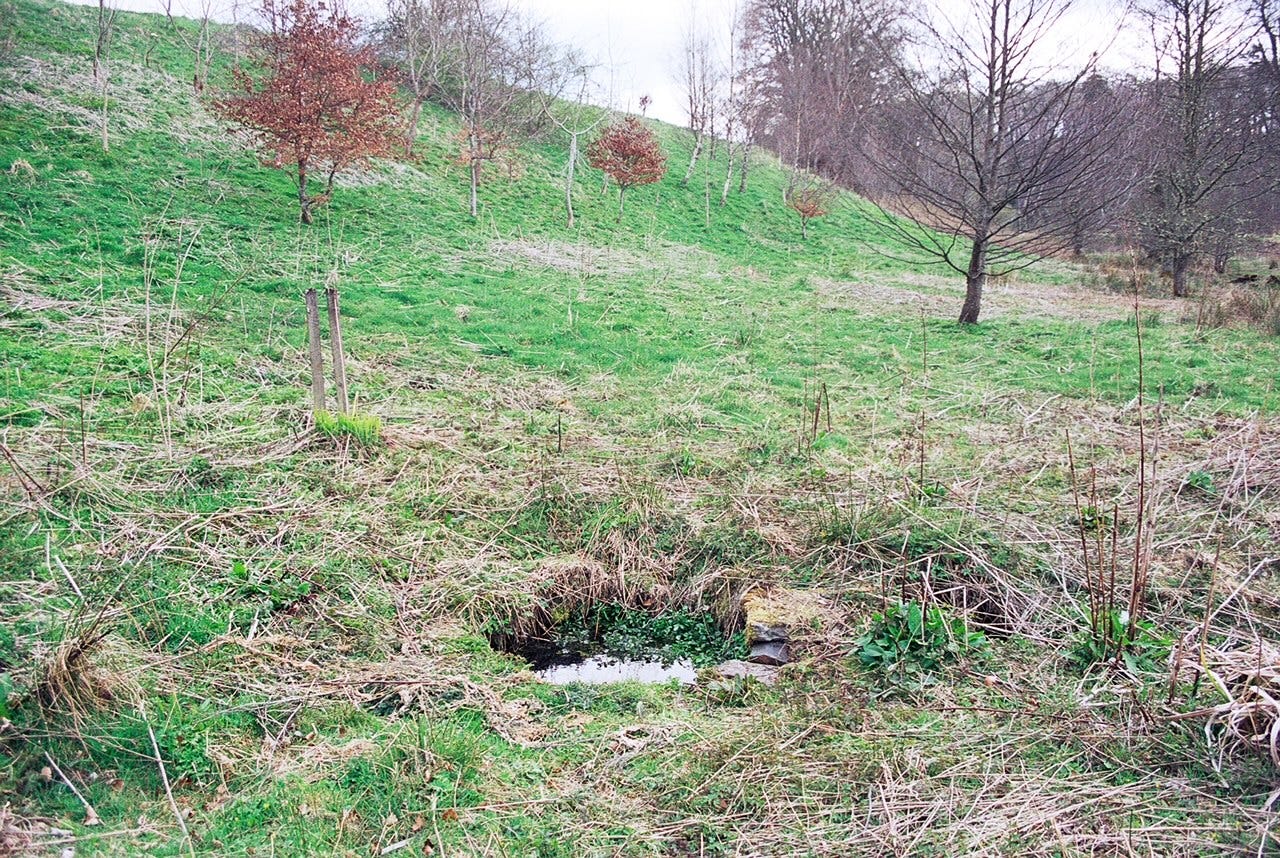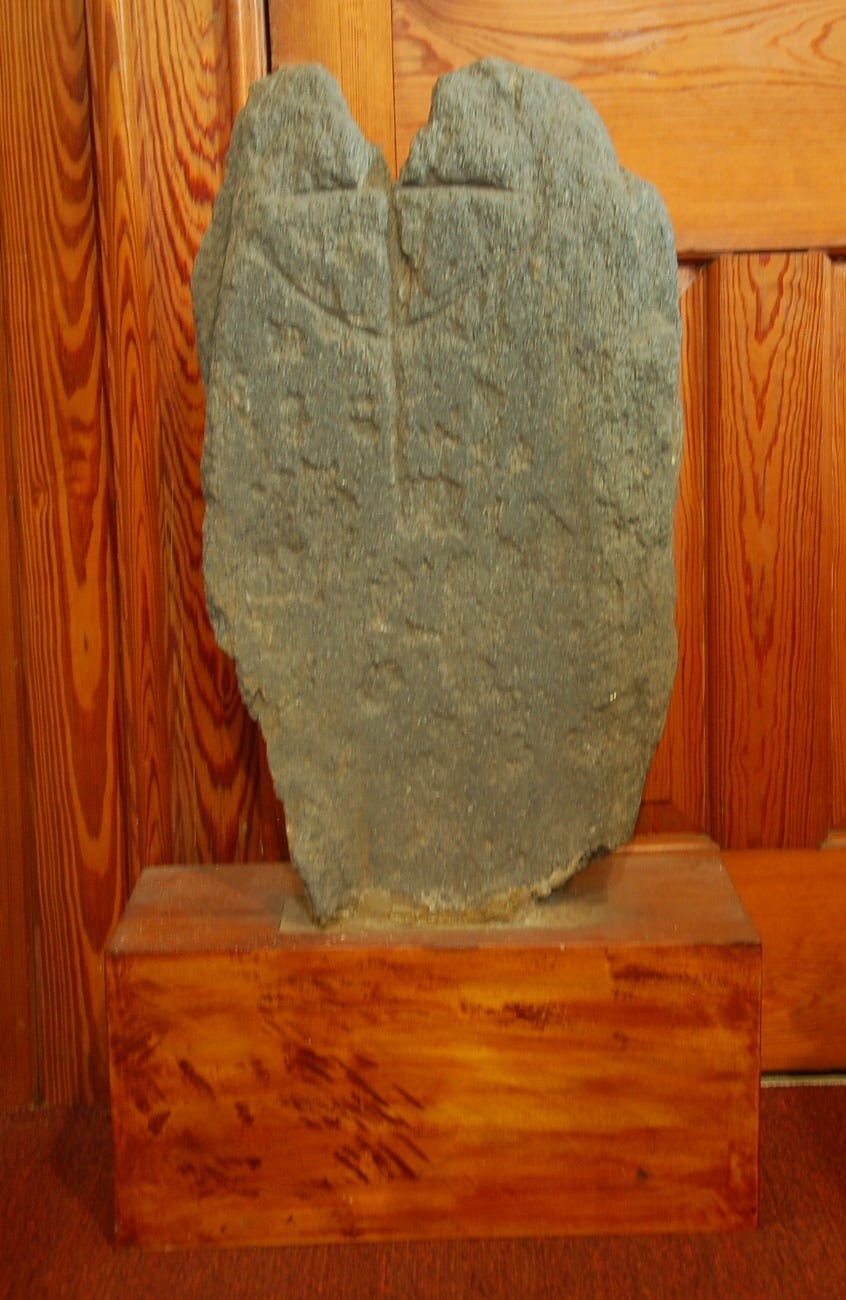Saint Fumac is a well known figure in the village of Drummuir in the valley of Botriphnie in Morayshire.
Little is known about Fumac, and there is no evidence that he existed. However, this is not in any way to say that he did not exist! There are many thousands of Saints, but it was not until the year 993 that formal recognition was introduced. Prior to this, and as Fumac lived here around the year 580, a Saint was proclaimed by popular demand, and his saintly nature and good works earned him the title.
St. Fumac is still known and relevant today. Fumac’s Well is still there and its waters are still used for baptisms in the adjacent Church, as it always has been, although it is boiled beforehand as a precaution. The annual Fumac’s Fair has been in existence for as long as records exist, and is still celebrated every May, at Drummuir Railway Station (which today is on the preserved Keith & Dufftown Railway line) A large modern wooden statue of Fumac dominates the site, created by local chain saw carver Gary Shand at the Drummuir 21 Community Woodland Day in 2011. In July 2021 a replacement statue, also hewn from a single tree, was installed, as the 2011 version had deteriorated with the N.E. Scotland weather.
We do not know where Fumac was born, nor when. However, when he was old enough, he went to Saint Ninian’s Candida Casa at Whithorn to study to be a priest. When he qualified, he was sent north to spread Christianity. He walked all the way to Braemar, over the Cairn O’Mount pass, and established a religious community at Dinnet.
Some time later he travelled onwards, and came to Botriphnie, around the year 572 AD. At that time, Botriphnie could have been an important place. The population of Botriphnie was recorded as 953 souls in 1755, dropping to 572 in 1821, rising to 714 by 1841. The 2011 census gives the population for Drummuir as 110 people, although the boundaries may be different.
He certainly found a spring of good, clear water, and decided to settle here. St. Fumac’s Well has never been known to run dry. It is approximately 1.4 metres in diameter, about 45 cms deep, and still produces abundant clear water.
The well did fall into disuse, but the Rev. Dr. James S. Stephen (the last Minister to reside in the Manse) encouraged the Parishioners in 1972 to clear the undergrowth, reclaim the well, and create a path to it.
The well water’s properties are also claimed to be the reason why the Ministers of the Church there, have always been long lived! In the last 2 centuries there have been Ministers serving here for 56 years, 53 years and 51 years.. The present church dates from 1820. In front of it in the graveyard are the remains of the previous church, dating from 1677. This earlier church was dedicated to St. Fumac. This, in turn, replaced an even earlier church dating from the 12th century.
St. Fumac was well known in the area and was concerned to help the sick and the suffering.
It is also claimed that once a year he would crawl around the boundary of Drummuir village on his hands and knees, praying constantly for the remission of the sins of the inhabitants, and for protection against the plague and pestilence. He also washed every morning, summer and winter, in the well water.
His good deeds and gentle manner endeared him to the inhabitants, so that when he died the people wanted to commemorate him and keep his memory alive. To do this, they would hold a Fumac Fair every May.
A wooden statue of Fumac was made, and on Fumac Fair day it would be processed around the village and down to the Fair, accompanied by bagpipers, singers, dancers and great merriment.
Between Fairs, the statue was in the charge of a widow of the village. One Fumac Fair, the widow took the statue, at the end of the procession, down to the well to wash it. The water from the washing was carefully kept, as it was believed to have curative powers. However, when the woman was washing it, it slipped from her hands into the river Isla which was in spate at that time, and it was washed away.
The statue went all the way down the Isla, and then the Deveron to Banff. Here, it was washed up on the sand banks there. It was spotted and taken to the local Minister, as it may have been a religious icon, or a pagan statue, or even a miracle. The Minister decided that it was a graven image obviously used by idolaters, and promptly had it broken up and burnt.
In the sanctuary of the Church there is a relic of St. Fumac’s days. In the early years following his death, the villagers carved a great Christian cross on a large stone, approximately 1.68 metres high. This standing stone was believed to have been used as a focal point of the Fair (maybe after the statue had been destroyed).
In either 1820 or 1840 the local blacksmith demolished the stone to use part of it as a hearth for his forge. This has been lost over time. However, a part of the stone is still in the church.
Another reminder of Fumac is at the farm of Mid Third. Here, the field nearest to Drummuir has always been known as “Fumac’s Field”. It is also believed that a field at Westerton Farm is also called “Fumac’s Field” and the annual fair may have been held here.
St. Fumac’s fair is organised by the environmental charity Drummuir 21. See www.drummuir21.co.uk, Drummuir 21 promotes the countryside, and the environment in and around Drummuir and Botriphnie, to be enjoyed by everyone. They maintain the all-abilities walking path network, promote the Fair, and many other events.
Tradition says that Fumac wore green tartan – but we have no details. In 2014, the pupils of Botriphnie Primary School studied St. Fumac, and decided that it would be a good project to create a new tartan for him. A group of senior pupils went to Johnston’s of Elgin woollen mills, and with their help, a bright and colourful tartan was produced. The pupils then sold the scarves at £12.50 each, to help school funds.The pupils followed this up with a video – see on “youtube” at botriphnie ad
In 2015, for the Fumac’s Fair, the Inverness Pipe Major, Mr. Lewis Barclay, composed the unique piece “Spirit of Fumac”, a slow air. This bagpipe music was sponsored by Drummuir Castle Estates.
It is good to keep alive this memory of a saintly man. It keeps people rooted in the area, gives a sense of continuing community, and involves local people of all ages in the annual event. Long may it continue.




